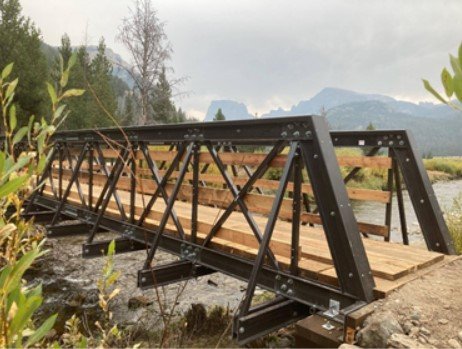Throughout this article, you will learn “what is a truss bridge” and explore the material and design options available. Note, this article is intended as a basic orientation and not a structural design guide.
What is a Truss Bridge?
A truss bridge is a load-bearing structure that contains multiple vertical, horizontal, and diagonal members. These are often configured in triangular shapes to transfer forces efficiently through a structure to maximize the strength of the structure using minimal materials. The full assembly of these members is called a “truss”. The trusses support the bridge and its weight over large span areas.
Truss Bridge Design Considerations
Now that you understand what is a truss bridge, next is the design. Every truss has a top chord and a bottom chord, which are the horizontal members. Top chords are in compression, bottom chords are in tension. Diagonals and/or verticals connect the top and bottom chords. These members may be in compression or tension. The configuration of the members can vary widely; however, there are several classic designs. The most common truss designs include the Pratt, the Warren, the Bowstring, and the Howe.
At Arete Structures, our most common truss bridge design is the Howe, where all the diagonal members are in compression.
Structurally, Arete Structures truss bridges contains five fundamental elements:
- Foundation/abutments and piers (for multi-span)
- Truss
- Floor beams and outriggers that connect and support the two trusses
- Stringers sit on top of the floor beams and support the decking
- Decking
When designing a truss bridge consider and review the design and environmental factors below.
#1 Determine the Bridge Loads and Dimensions
To design the bridge you will need to know:
- The use criteria
- How far the bridge needs to span (e.g. across a stream)
- Width needed (just foot traffic vs light vehicle)
- Design load (both live load and dead loads)
- Live loads include:
- Expected foot traffic
- Expected bike, equestrian, or lightweight vehicle traffic
- Dead loads include:
- Weight of the structure itself
- Decking (wood, FRP, etc.)
- Live loads include:
- Snow and wind loads (can vary greatly depending on location)
- Environmental considerations (e.g. potential for flooding)
Truss Bridge Material Options
Once you understand the design needs, you can review the material options available to find the best one. The three most common bridge material options are fiber reinforced polymer (FRP), steel, and wood.
Comparing Lifespan, Weight, and Cost
FRP Lifespan: 100+ years, corrosion-resistant
Steel Lifespan: 100-year lifespan, will corrode over time
Wood Lifespan: 30-year lifespan, will rot over time
FRP Weight: approximately 125 pounds per cubic foot
Steel Weight: approximately 500 pounds per cubic foot
Wood Weight: approximately 52 pounds per cubic foot
FRP Cost: Higher upfront cost, lower construction cost
Steel Cost: Lower upfront cost, higher construction cost
Wood Cost: Lowest upfront cost, higher construction, and replacement costs
What to Expect from an FRP Truss Bridge?
FRP truss bridges typically span from 25-80 feet long; they can even reach up to 100 feet in length. This type of bridge works great for:
- Remote trail location
- Community spaces
- Equestrian trails
- Nature trails
- National parks
FRP is a popular lightweight material option for pedestrian, equestrian, and lightweight vehicle bridges.
Advantages of FRP include:
- Easier access to inaccessible lands
- Quick assembly with unskilled or an inexperienced crew
- Several customized options with various rail, curb, and decking choices
- Minimal maintenance
Disadvantages of FRP include:
- Unique design constraints
- Approximately 60% of the tensile and compressive strength of steel
- Approximately 10% of the modulus of elasticity
- Adjusts for the design by building mechanical camber into the bridge
- Higher upfront costs; however, these are often offset by lower construction costs and increased lifespan
Learn More about FRP Truss Bridges for Your Next Project
Areté Structures partners exclusively with Strongwell, the world’s largest FRP manufacturer. The Areté Structures Truss Bridge is an economical solution for your longer span bridge needs. Once you’re ready for a truss bridge quote, contact the Areté Structures team to get started.

